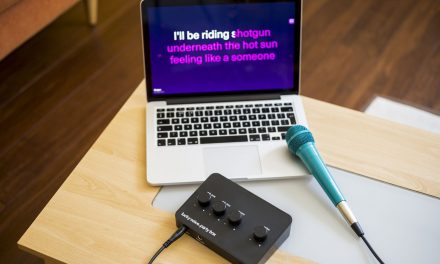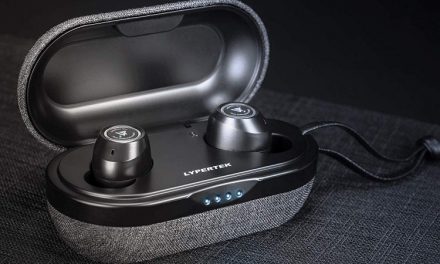With the OneOdio FM1 microphone coming in at around the £40 mark, we take a look at a low to mid-range budget microphone and find out if it’s worth your money.
First Impressions

When taking a first look at the OneOdio FM1 microphone, I instantly saw many positives in terms of what is in the box and the high quality feel you get from just looking at the microphone.
The OneOdio FM1 has a matte black on black finish, which although the predominant material of the mic is plastic, it gives the FM1 a classy and premium feel. The mic is accompanied by a heavy but sturdy flat round base that simply attaches to the bottom of a metal stalk.

The OneOdio FM1 being stubby and compact also helps with the sturdiness, as you know that when it’s on your desk, it won’t be sliding around all over the place.
A USB-C to USB-A lead that you plug into the back of the mic is the only wire that you need, which is a big plus for the FM1 as in my opinion, you don’t end up getting yourself tangled up in and endless clump of wires and you can very easily take the FM1 itself from place to place.

Overall, with its clean finish, sleek black colourway, and solid materials, I the OneOdio FM1 starts out fresh from the box as looking like a very promising piece of kit.
Other than the pop filter which you attach to the bottom base in between the stalk’s end and the base, the whole mic is essentially ready for action straight out the box.

This is a very convenient and user-friendly feature as when you get a new piece of tech, you want to get it out the box and crack on with actually using your microphone, you don’t want to be fiddling around for ages putting bits and bobs together.
Specifications:
OneOdio FM1
- Type: Condenser
- Polar Pattern: Cardioid
- Sampling Rate: (44.1 to 48) kHz / 16 bits
- Frequency Response: 20 Hz – 20 kHz
- Sensitivity: -38 dB ± 2 dB
- Maximum SPL: 110 dB
- Signal-to-Noise Ratio: ≤ 91 dB
- Total Harmonic Distortion: ≤ 0.5 ﹪ (1 kHz)
- Monitor Output Type: 3.5 mm
- Monitor Output Impedance: 32 Ω • Monitor Output Power: 10 mW
- Operating Voltage: (5 ± 0.5) VDC
- Operating Current: 500 mA
Design

With every component on the microphone being black, this mic strikes a very premium and sleek appearance when you have it set up on your desk. The material of most of the set-up being plastic is a slight let down as I think that there’s something about some metal features that gives you a fully premium feel with microphones, but for around £40, you can’t really complain much.

Despite plenty of plastic, the overall set-up and solidity is one of top marks, with as I mentioned before, a strong and sturdy base, which leaves small room for slight wobbles or tumbles. You don’t want the sounds of your microphone movement to be picked up on the microphone, so the stand being secure and steady is a big plus as you have peace of mind that when you are recording, won’t have these mishaps.
The pop filter is pretty decent when you consider the price of the OneOdio FM1. Although the effects of the mesh filter aren’t exactly going to blow your mind, it does what it says on the tin so I can’t really complain.

It has a flexible stalk that you can swivel and bend to suit whatever needs you require, just like with how the mic itself can swivel. Some microphones for this budget of around £40 can be quite stiff and in a set position, so the option of a more personalized setup is definitely welcome.
Combine the flexibility of the mic with the compact and sturdy build, you have yourself a very versatile microphone in the OneOdio FM1. That’s not even with the mention of it’s plug-in-and-play nature that allows for great portability and the ability to quickly get going with your recordings.
Sound Quality
The OneOdio FM1 does a decent job in performing above its price tag. The overall quality of the sound was relatively average, with a lack of background noise cancellation being slightly underwhelming, however again for the price, it is definitely solid.

The pop filter had its desired effect of eliminating plosives and pops as well as things such as wind from speaking, although like I said previously, it isn’t anything world beating.
As for the actual mic, the OneOdio FM1 has opted for a cardioid pickup pattern, not bothering with any of the alternative patterns that you see in many other microphones. This allows OneOdio to focus fully on specifically perfecting the cardioid, as opposed to juggling a multitude of patterns.

A Cardioid pattern concentrates mostly on the very front of the microphone, with the highest sensitivity to sound coming in directly from the front. This means there’s essentially no sensitivity to sound coming directly from behind and a reduced sensitivity to sound coming in from the sides, meaning you won’t be picking up background noises from around the mic.
This is a very handy feature for desktop microphones like the FM1 as it helps greatly in eliminating unwanted and annoying sounds, such as the clicking of a mouse, the noise of someone else in your room or any nearby noise that could disrupt your recording.
The OneOdio FM1 also has an excellent off-axis suppression function, allowing it to capture more natural sound and suppress unwanted background noise.
The OneOdio FM1 is equipped with a high-quality professionally audio chipset so you can have no doubts whatsoever that any voice recordings will be that of clarity and strength, similar to many studio microphones which is highly impressive for a simple plug-in-and-play desktop microphone.
Other Features
The OneOdio FM1 is compatible with Windows, PS4/5 macOS and Linux, basically anything with a USB 2.0 data port, making life easy when buying this as you will not have the awkward moment where the mic doesn’t work on your specific device.

This along with the simple plug-n-play functionality adds to the ongoing feeling that I get with this mic that it is very good for quick instances where you need a microphone, but also not having to settle for something that isn’t as high quality as you would like purely because it’s portable.
The OneOdio FM1 is also donned by a selection of nifty buttons that help further personalize your experience. At the top of the FM1 there is a gain knob for controlling the sensitivity.

A mute button is always welcome, with an LED-lit microphone symbol that glows green the microphone is active and red means it’s been set to mute.
There is also a ‘passthrough’ button which is pair of headphones for its symbol. When active, it will glow green and allow you to hear your voice through your headphones, if you use the 3.5mm headphone jack on the bottom.
This is a great feature for gamers and streamers, as it enables you to hear back your voice through your headphones, allowing you to review and adjust any settings to ensure your teammates or audience can hear you in the best way possible.
Final Thoughts
RATING: 4.2/5
To conclude, the OneOdio FM1, for its price of around £40, is a very decent microphone option for those who don’t want to spend the big bucks on a studio mic, but still want something that delivers in quality.
You get a stable and sturdy microphone that offers good quality sound for the price, along with its great portability, simplicity of set-up and multitude of buttons that can give you a real personalized feel.
I recommend this mic to predominantly streamers or YouTubers as for only £40, you get yourself a good little microphone that will get you by before you can afford some high-level, studio-like microphone. However, if you simply just need a microphone for whatever reason, there’s no doubt that the OneOdio FM1 is a great choice for the budget range of around £40.










Recent Comments